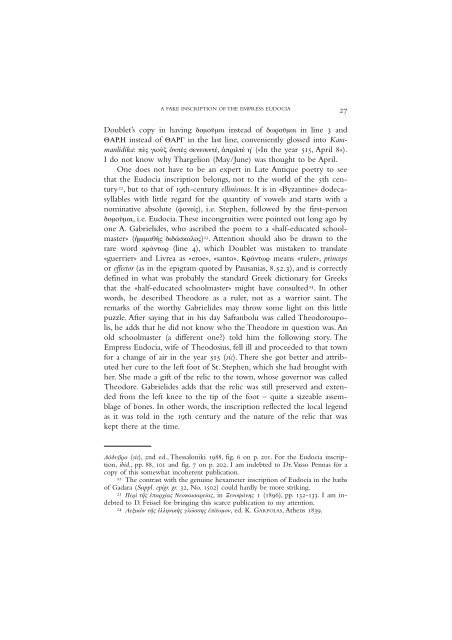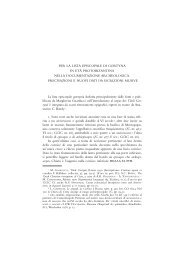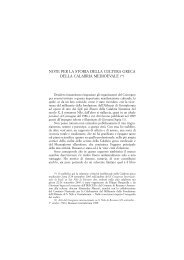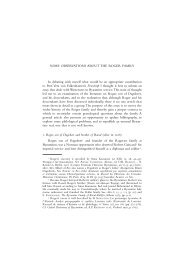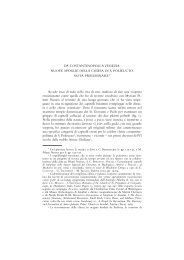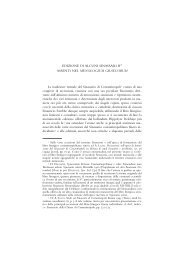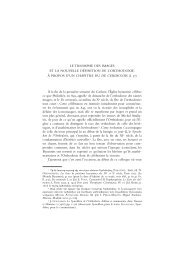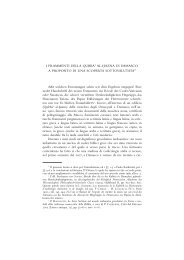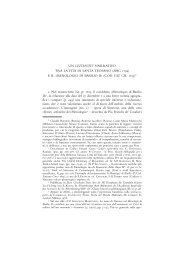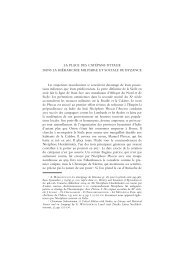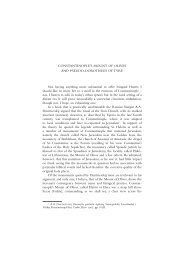Cyril Mango
Cyril Mango
Cyril Mango
You also want an ePaper? Increase the reach of your titles
YUMPU automatically turns print PDFs into web optimized ePapers that Google loves.
A FAKE INSCRIPTION OF THE EMPRESS EUDOCIA 27<br />
Doublet’s copy in having δµµαι instead of δωρµαι in line 3 and<br />
ΘΑΡ.Η instead of ΘΑΡΓ in the last line, conveniently glossed into Karamanlidika:<br />
πς γι νπς σενεσιντέ, πριλτ η («In the year 515, April 8»).<br />
I do not know why Thargelion (May/June) was thought to be April.<br />
One does not have to be an expert in Late Antique poetry to see<br />
that the Eudocia inscription belongs, not to the world of the 5th century<br />
22 , but to that of 19th-century ellinismos. It is in «Byzantine» dodecasyllables<br />
with little regard for the quantity of vowels and starts with a<br />
nominative absolute (φανείς), i.e. Stephen, followed by the first-person<br />
δµµαι, i.e. Eudocia.These incongruities were pointed out long ago by<br />
one A. Gabrielides, who ascribed the poem to a «half-educated schoolmaster»<br />
(µιµαθς διδάσκαλς) 23 . Attention should also be drawn to the<br />
rare word κράντωρ (line 4), which Doublet was mistaken to translate<br />
«guerrier» and Livrea as «eroe», «santo». Κράντωρ means «ruler», princeps<br />
or effector (as in the epigram quoted by Pausanias, 8.52.3), and is correctly<br />
defined in what was probably the standard Greek dictionary for Greeks<br />
that the «half-educated schoolmaster» might have consulted 24 . In other<br />
words, he described Theodore as a ruler, not as a warrior saint. The<br />
remarks of the worthy Gabrielides may throw some light on this little<br />
puzzle. After saying that in his day Safranbolu was called Theodoroupolis,<br />
he adds that he did not know who the Theodore in question was. An<br />
old schoolmaster (a different one?) told him the following story. The<br />
Empress Eudocia, wife of Theodosius, fell ill and proceeded to that town<br />
for a change of air in the year 515 (sic). There she got better and attributed<br />
her cure to the left foot of St. Stephen, which she had brought with<br />
her. She made a gift of the relic to the town, whose governor was called<br />
Theodore. Gabrielides adds that the relic was still preserved and extended<br />
from the left knee to the tip of the foot – quite a sizeable assemblage<br />
of bones. In other words, the inscription reflected the local legend<br />
as it was told in the 19th century and the nature of the relic that was<br />
kept there at the time.<br />
∆άδυρα (sic), 2nd ed., Thessaloniki 1988, fig. 6 on p. 201. For the Eudocia inscription,<br />
ibid., pp. 88, 101 and fig. 7 on p. 202. I am indebted to Dr.Vasso Pennas for a<br />
copy of this somewhat incoherent publication.<br />
22 The contrast with the genuine hexameter inscription of Eudocia in the baths<br />
of Gadara (Suppl. epigr. gr. 32, No.1502) could hardly be more striking.<br />
23 Περ τς παρίας Νεκαισαρείας, in ενφάνης 1 (1896), pp. 132-133. I am indebted<br />
to D. Feissel for bringing this scarce publication to my attention.<br />
24 Λεικν τς λληνικς γλώσσης πίτµν, ed. K. GARPOLAS, Athens 1839.


